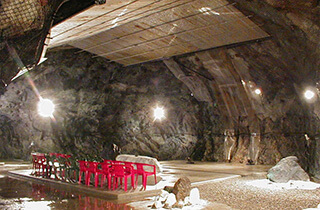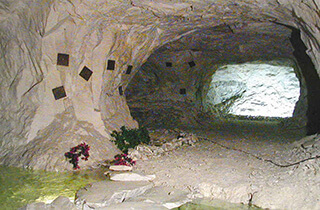Resource Development Division
- HOME
- Business Information
- Mineral Resources Segment
- Resource Development Division
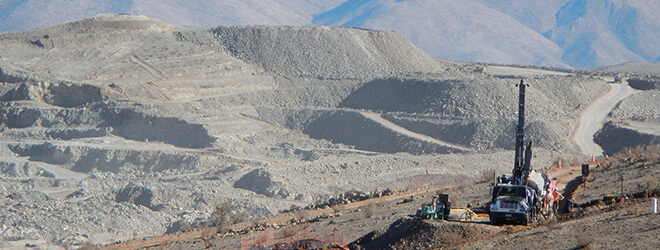
Actively exploring and developing steel raw materials and copper concentrate around the world
The Resources Development Division of our company has consistently dealt with the exploration and development of natural underground resources in Japan, a country known to be poor in natural resources. This division’s activities cover not only domestic metal and nonmetal resources, but also overseas mineral resources such as materials for steel manufacturing, copper ore, and other materials in Southeast Asia, South America, and the Near and Middle East.
In the north of the Republic of Chile in South America, we have been searching for copper mines around the existing Atacama Copper Mine, especially for manto-type copper deposits. And we have applied remote sensing technology for this exploration, analyzing satellite images of promising areas and efficiently selecting, applying for, and acquiring mining concessions. Later, we will fully explore all these opportunities. And, we have also gone ahead with acquisition opportunities in Southeast Asia. In Republic of Fiij in the South Pacific, we detected a remarkable porphyry copper mineralization, so we began in-depth inspections. We also evaluated these deposits, looking at the economic viability with two other companies, including one from overseas. In this way, we will continue to explore for opportunities over the world.
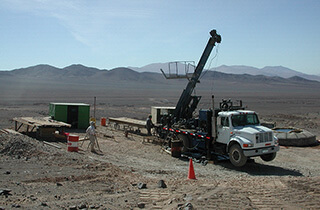
(underground quarry for rock samples)
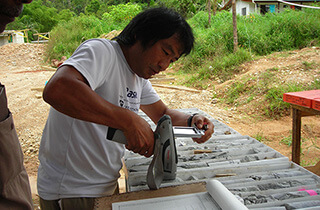
(at the Republic of Fiji)
From now on, to establish a stable supply of resources in the 21st century, our company will carry out global explorations and development especially for securing limestone and nonmetal resources in China and other Asian countries and copper resources in the circum-Pacific region, including South America, Australia, and Southeast Asia.
Even though exploration and development of a new mineral deposit will not be achieved in a day, our company will take every effort to secure a stable supply of natural resources.
Use of underground spaces and caves
Our limestone mines in Japan use open pit mining. However, our roots can be traced back to 1899 with the former Futase Coal Mine of the state-owned Yawata Steel Works. Until we shifted to limestone in the 1940s, our operations focused on pit mining, such as coal mines, iron ore mines, and copper mines. The Kamaishi Mine in Kamaishi City, Iwate Prefecture is well known in Japan as both an iron ore mine and the birthplace of the country’s modern steelmaking. The Kamaishi Mine was initially a state-owned and operated steel mill until we took over iron ore mining operations from 1939. Today, the site is operated and administered by our subsidiary Kamaishi Kozan Co., Ltd. Beginning as mine for iron ore, copper concentrate, and white limestone, today operations focus on the extraction and sale of mineral water. Since the Kamaishi region is home to strong bedrock, including granite and limestone, even now many of the caves are maintained in a usable condition.
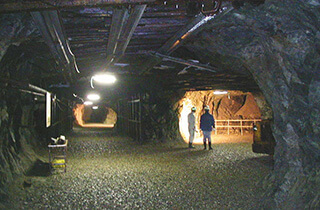
Use of caves at the Kamaishi Mine
The Kamaishi Mine has many underground spaces, including more than 140 kilometers of mine shafts, inclined shafts, vertical shafts, massive quarry sites, and caves for pit mining, among others.
The core business of Kamaishi Kozan is mineral water (since 1989). The mainstay brand of natural mineral water, called Sennin-Hisui, can be found on store shelves in Japan. Kamaishi Kozan has bored even deeper underground to extract high-quality, low-alkaline natural mineral water. Deeper into the mine, Kamaishi Kozan uses a unique underground dam to generate power using the former site of the quarry. Nearly all of the electricity used for power water extraction and the bottling plant is generated by this underground power source.
Various forms of testing and research have been conducted over the years capitalizing on the Kamaishi region’s robust bedrock, stable underground cave environment (constant temperature and stable humidity), and wealth of spring water. These have included elastic wave testing, crustal stress testing, earthquake observation, sound and light testing, cloud physics testing, and in situ testing to determine geochemistry, flow characteristics and fissures of deep bedrock.
In some areas, caves contain numerous unused spaces. There are many potential uses for these caves.
For details, see the page of the Kamaishi Mine information page (Japanese version only) on the Kamaishi Kozan website.
